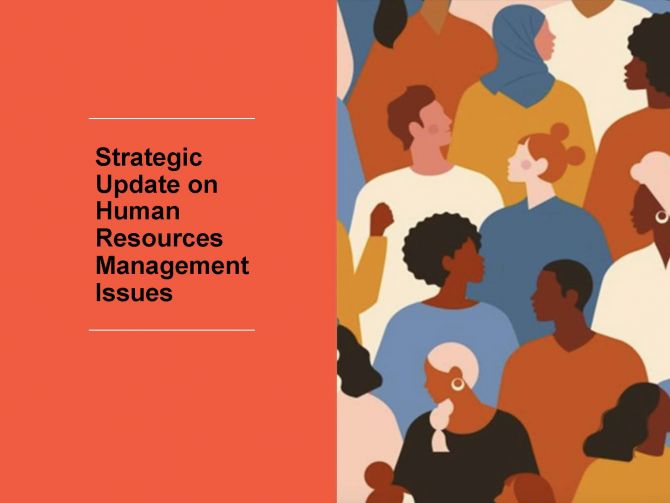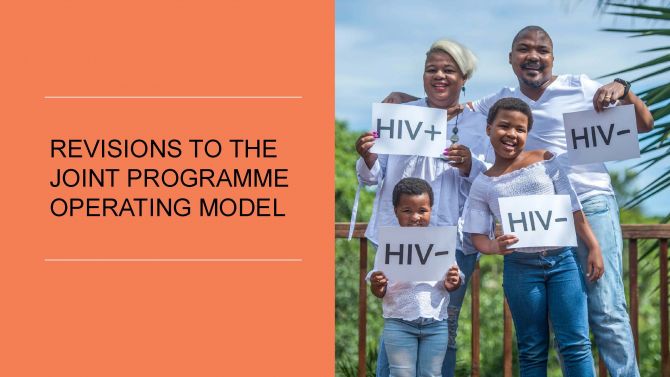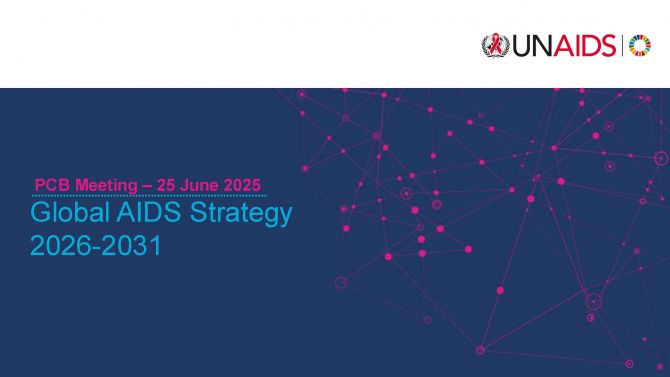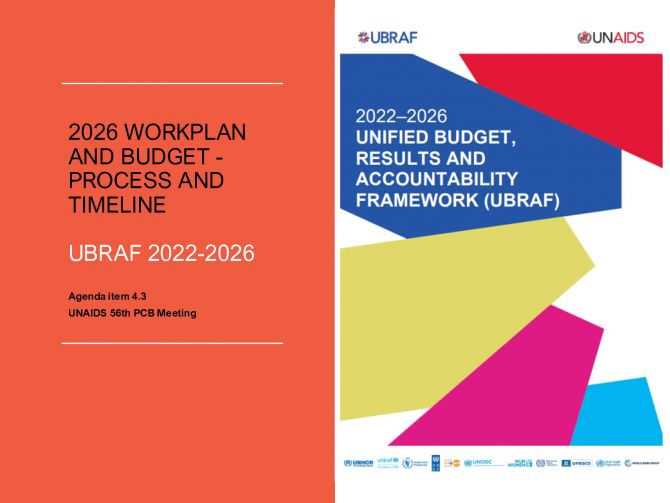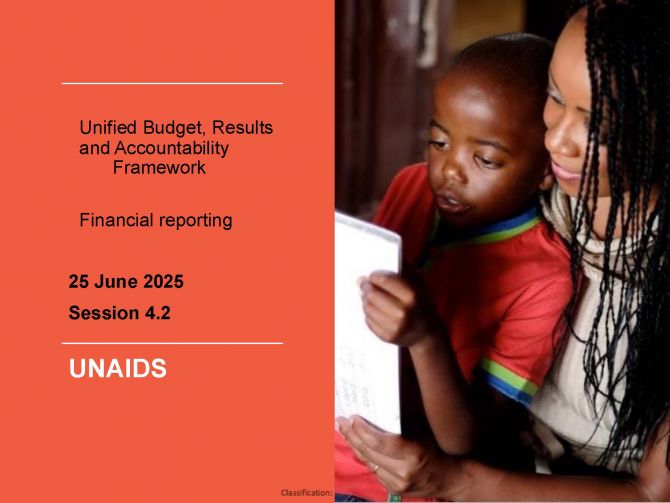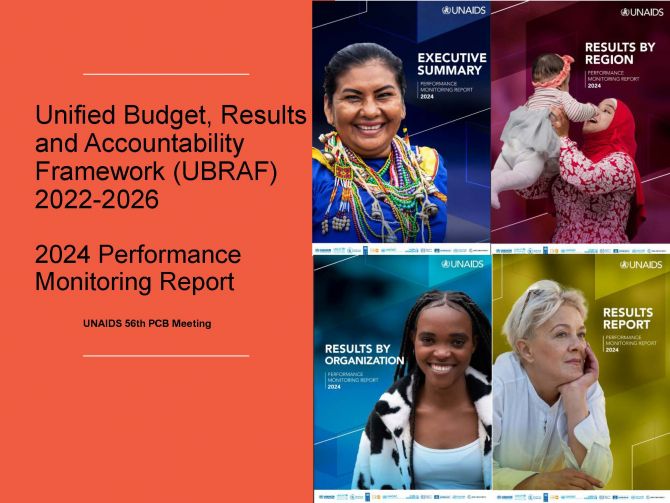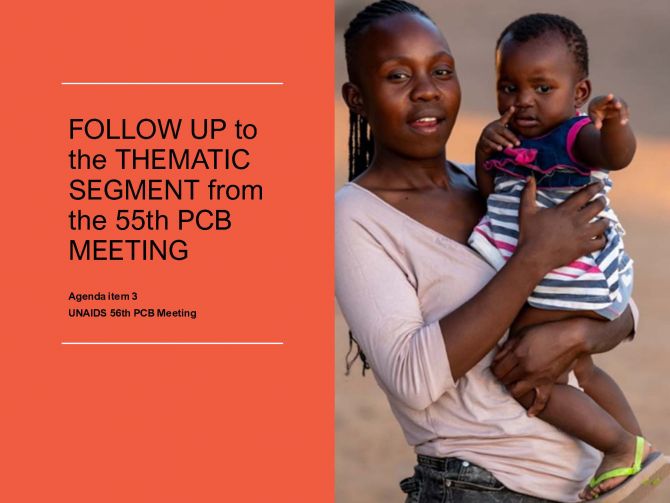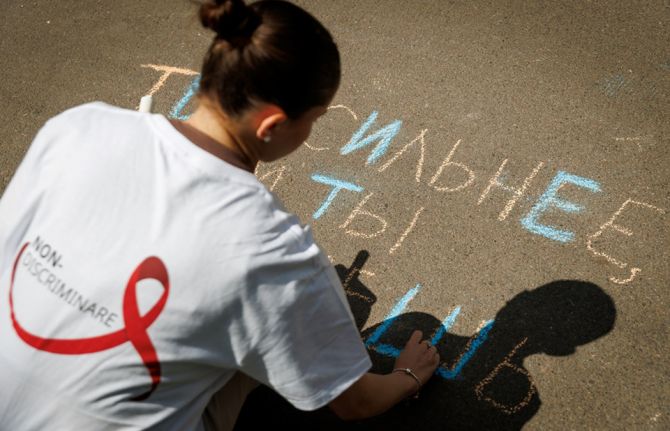


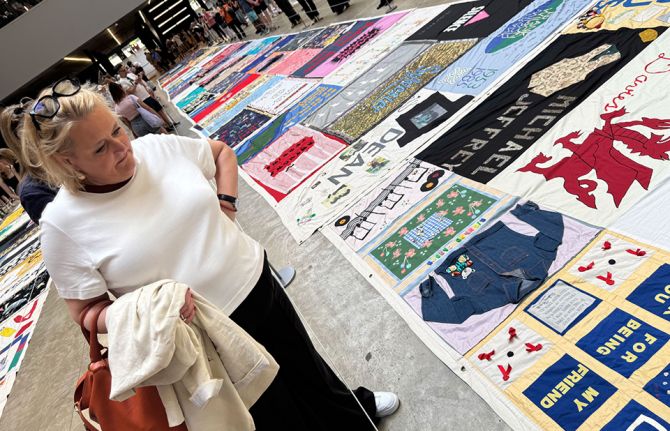
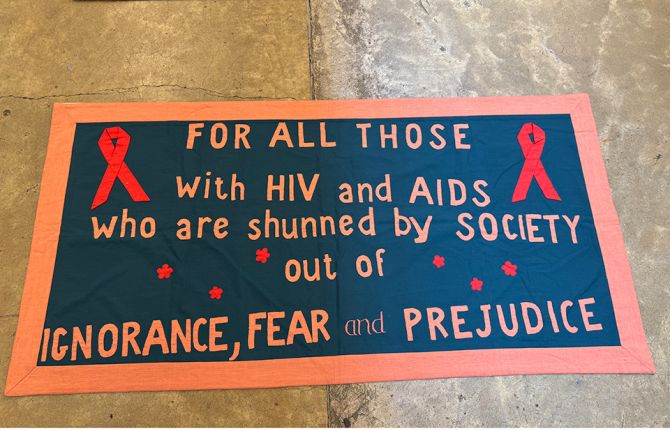
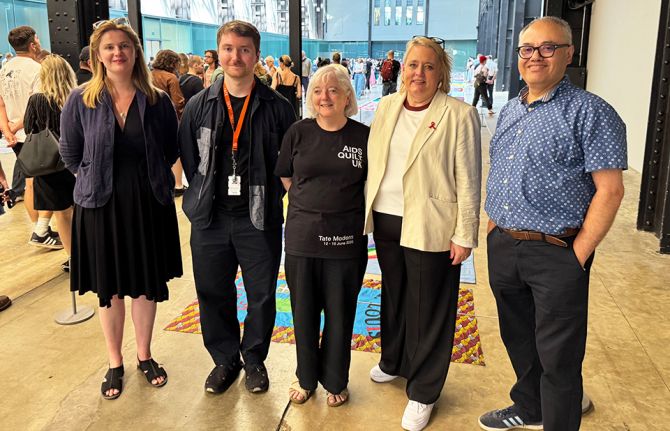
Feature Story
Tate Modern exhibits UK AIDS Quilt, a powerful tribute to people lost to AIDS
26 June 2025
26 June 2025 26 June 2025The Tate Modern art gallery in London paid a powerful tribute to lives lost to AIDS by exhibiting the UK AIDS Memorial Quilt which features hand-stitched panels commemorating people whose lives were cut short by the disease. It is the largest ever showing of the UK Quilt in history.
On Monday 16 June UNAIDS Deputy Executive Director Christine Stegling paid a special visit to the exhibition. “It was beautiful and sombre in equal measures,” Ms Stegling reflected. “I was reminded of the loss we have all experienced. Of the dark times we have come from.”
Created in the 1980s, the UK AIDS Quilt contains 42 panels, each made up of a collection of smaller panels, created by loved ones of those who died of AIDS. The idea of an AIDS memorial quilt started in the United States as a way to commemorate the lives of people who died from AIDS-related causes. It paid tribute to friends and loved ones as sadly, those who died were often not given funerals because either their families rejected them, or funeral homes refused to take their bodies for fear of infection.
Ms Stegling’s visit underscored the importance of remembrance and perseverance, and the need to centre human dignity in public health responses. The exhibition reminds people how far the world has come in the fight against HIV—today, 30 million of the 40 million people living with HIV are on life-saving antiretroviral treatment. However, it also demonstrates profoundly that there is much still to be done to tackle the stigma and discrimination associated with HIV.
Ms Stegling’s visit was part of a broader mission to the UK. In her remarks at the British Group Inter-Parliamentary Union Pride Reception the next day, Ms Stegling warned of the devastating impact of recent funding cuts to foreign assistance, particularly the reductions in US funding and r in UK development assistance which are already undermining progress against AIDS. These cuts included defunding community-led efforts which are critical for reaching all people at risk for and living with HIV.
“Community-led efforts customized to meet the needs of LGBTIQ+ communities were among the first services defunded,” she said, highlighting the disproportionate impact on marginalized groups. UNAIDS estimates that without previous funding levels fully restored, or offset, there could be up to 6.6 million additional new HIV infections and additional 4.2 million AIDS-related deaths.
Despite these challenges, Ms Stegling emphasized the power of communities to drive progress. “Ending AIDS is no longer aspirational—it is achievable,” she told parliamentarians and civil society leaders. She called on the UK to continue its legacy of leadership by investing in equitable access to lifesaving HIV services and by supporting grassroots organizations critical for connecting people to healthcare. “Community leadership, compassion, courage—and solidarity—this is what works,” she said, urging renewed commitment to the 2030 goal of ending AIDS as a public health threat.
Ms Stegling’s UK visit, including her engagement with lawmakers and civil society during Pride Month, served as a poignant reminder that while the fight against AIDS is far from over, it can be with sufficient support for the right approaches. Her presence at the Tate Modern and her powerful advocacy at the parliamentarian reception reaffirm UNAIDS’ call to action: to fund what works, protect those most at risk, and ensure that no one is left behind in the global AIDS response.
Region/country
Related


Press Release
Flanders signs new two-year agreement with UNAIDS including €1.5 million contribution to help end AIDS in Africa
25 June 2025 25 June 2025GENEVA, 25 June 2025— UNAIDS and Flanders have strengthened their joint efforts to combat the AIDS pandemic in Africa by signing a new cooperation agreement covering the period 2025—2026.
“I want to thank Flanders for their reliable and continued support to UNAIDS and for their strong leadership during this critical phase of the AIDS response,” said UNAIDS Executive Director, Winnie Byanyima. “In these uncertain times, the consistency of Flanders’ engagement is highly appreciated and greatly valued.”
The agreement was signed during the 56th meeting of the UNAIDS Programme Coordinating Board, with the Flemish delegation headed by Katrien de Pauw, General Representative of Flanders to the United Nations in Geneva.
“To end AIDS by 2030, we must stay the course—we're close, now is not the time to give up. Flanders remains firmly committed to a sustainable finish,” said Ms de Pauw.
The €1.5 million contribution includes an annual €250,000 in core unspecified funds, €250,000 per year in core specified support for Mozambique, and €250,000 per year in core specified support for the seven other most affected countries of Southern Africa.
“This funding from Flanders will make a significant difference to the lives of people living with and affected by HIV in Mozambique, especially for women and girls and other marginalized and vulnerable groups of people. Hartelijk Bedankt Vlaanderen (Thank you Flanders)!” said Phillipe-Serge Degernier, a Belgian national and UNAIDS country director for Mozambique.
With 2.4 million people living with HIV in 2023, Mozambique has the second largest HIV epidemic after South Africa. A total of 2.1 million people in the country are on treatment to keep them well. However, the pause in US funding and the reduction to other international funding streams have complicated efforts to maintain HIV treatment, care and prevention efforts in the country and across the region.
UNAIDS
The Joint United Nations Programme on HIV/AIDS (UNAIDS) leads and inspires the world to achieve its shared vision of zero new HIV infections, zero discrimination and zero AIDS-related deaths. UNAIDS unites the efforts of 11 UN organizations—UNHCR, UNICEF, WFP, UNDP, UNFPA, UNODC, UN Women, ILO, UNESCO, WHO and the World Bank—and works closely with global and national partners towards ending the AIDS epidemic by 2030 as part of the Sustainable Development Goals. Learn more at unaids.org and connect with us on Facebook, Twitter, Instagram and YouTube.
Region/country

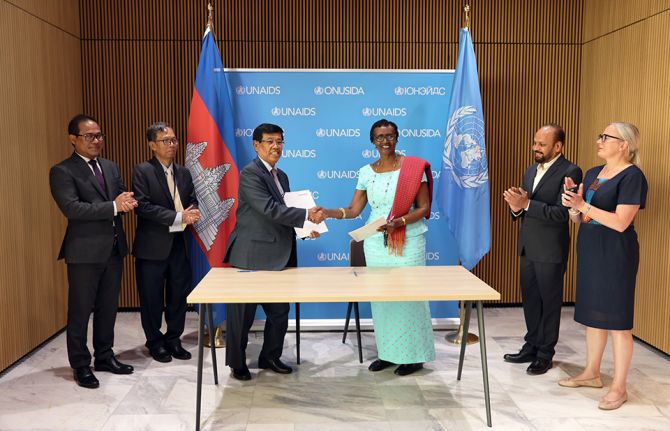
Press Release
Cambodia signs new cooperation agreement with UNAIDS and pledges US$ 100,000 in funding
24 June 2025 24 June 2025GENEVA, 24 June 2025—Cambodia has strengthened their joint efforts to combat the AIDS pandemic by signing a new cooperation agreement with UNAIDS for a year and pledging US$ 100,000.
“This contribution shows the importance Cambodia places on UNAIDS, the HIV response, and the multilateral system,” said UNAIDS Executive Director, Winnie Byanyima. “Considering the significant cuts the global AIDS response faces, we thank you and we appreciate your solidarity.”
Cambodia is on track to achieve the 95-95-95 Global AIDS Strategy targets. Currently 92% of people living with HIV are aware of their status, almost all diagnosed people are on treatment, while more than 98% of those on treatment are virally suppressed. Since 2010, new infections have decreased by 45%. This is a greater decline than overall global results and more than three times faster than the average Asia-Pacific rate of decline.
A Cambodian delegation attended the 56th UNAIDS Programme Coordinating Board (PCB) meeting in Geneva June 24-26, headed by Ieng Mouly, Senior Minister and Chair of the National Cambodia AIDS Authority as well as Dara In, Ambassador and Permanent Representative of Cambodia in Geneva, Switzerland.
“This contribution from the Royal Government of Cambodia is not just a financial investment in the global HIV response,” said Ieng Mouly. “This is also a symbol of our belief in UNAIDS, the UN Joint Programme on HIV, and the multilateral system. Therefore, financial support to UNAIDS is crucial. We urge other countries to commit and invest in UNAIDS to make ending AIDS a reality.”
Cambodia has been a board member of the UNAIDS PCB since 2023 and has recently been re-elected for a second term (2026–2028).
UNAIDS
The Joint United Nations Programme on HIV/AIDS (UNAIDS) leads and inspires the world to achieve its shared vision of zero new HIV infections, zero discrimination and zero AIDS-related deaths. UNAIDS unites the efforts of 11 UN organizations—UNHCR, UNICEF, WFP, UNDP, UNFPA, UNODC, UN Women, ILO, UNESCO, WHO and the World Bank—and works closely with global and national partners towards ending the AIDS epidemic by 2030 as part of the Sustainable Development Goals. Learn more at unaids.org and connect with us on Facebook, Twitter, Instagram and YouTube.

